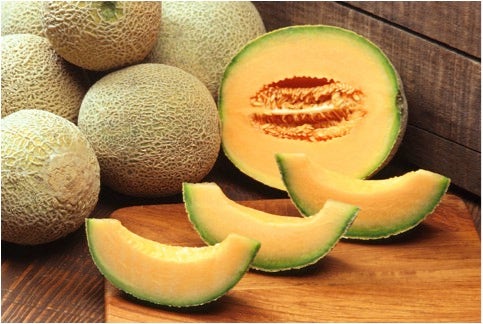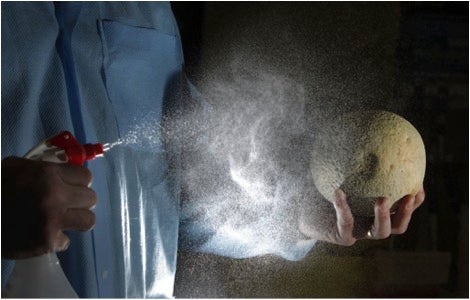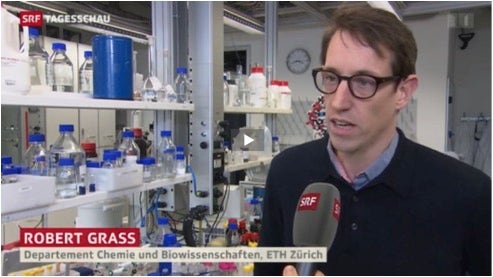- Fork-to-Farm Traceability Proven Practical
- Uses qPCR Decoding of DNA Barcode “tags”
- Consumer Concerns May Curb Commercialization
In earlier blogs here I’ve highlighted how sequencing of DNA barcodes has been used to identify fraudulent food sales—such as cheap meat or fish passed off as expensive steak or sashimi—and the same for mislabeled herbal products. Now, I’d like to share with you some nifty work by researchers who have applied qPCR to detect DNA barcode “tags” to follow foodstuff from your fork back to the farm (or farms) from which it originated.
This is not a simple goal to achieve, scientifically, and would certainly have been exceedingly useful, societally, in tracing the origin of food-related incidents such as listeria-contaminated cantaloupes that led to 29 deaths several years ago. In fact, just a few weeks ago there was a deadly outbreak of salmonella linked to cucumbers imported from Mexico wherein 4 people died and 732 were sickened by the bacteria.
 They all look the same, but sometimes it’s very important to find out where they came from. Taken from en.wikipedia
They all look the same, but sometimes it’s very important to find out where they came from. Taken from en.wikipedia
Spinning Down Encapsulated DNA Tags
Spinning down particles is routinely used as a relatively simple method for physical separations in the lab, but applying such centrifugation to isolating synthetic DNA tags in foodstuff is hardly trivial. One approach to such food-labeling was recently reported in the Journal of Agricultural and Food Chemistry by a Swiss team led by Prof. Robert Grass. In this application, synthetic silica particles with encapsulated DNA (SPED) were added to milk at concentrations as low as 10 parts-per-billion (ppb) SPED. Different SPED tags are used for each batch at a given dairy farm, and different dairy farms use different tags. This allows the milk in yogurt or cheese to be traced back to its farm of origin. Such traceability becomes vitally important in the case of a product recall or product contamination.
 Silica Particles with Encapsulated DNA (SPED) for tracking milk-derived products. Taken from Bloch et al. J. Agric. Food Chem., 2014.
Silica Particles with Encapsulated DNA (SPED) for tracking milk-derived products. Taken from Bloch et al. J. Agric. Food Chem., 2014.
Importantly, SPED cleverly utilize multiple properties of silica (silicon dioxide; aka sand, quartz) that include its ability to incorporate synthetic DNA and then preserve it against degradation in foodstuffs during storage, shipment and processing. SPED is also—theoretically at this stage of development—safe to consume, since these ~140 nm silica nanoparticles are presumed to be neither digested nor thought to be harmful in vivo—see more on this below.
Cost-wise, SPED are relatively inexpensive since each ton of milk tagged at 10 ppb reportedly adds only ten cents to the cost of production! The authors’ state that it’s possible to use SPED tracers as low as 0.1 ppb, which translates to only 0.1 ug of tracer per kg (2.2 pounds) of foodstuff, and can be generalized to any food from which SPED can be extracted for qPCR. The well-known sequence-specificity and exquisite sensitivity of qPCR—down to only a few molecules, or even just one—are also part of the cleverness of this approach.
Part of the trick to apply SPED for foodstuff tracing is to develop robust methods for isolating SPED from complex, challenging samples such as cheese to allow for isolation by centrifugation. That’s followed by another trick, namely, buffered oxide etch (BOE) to release the DNA for its decoding and quantitation by conventional qPCR. I had never heard of BOE and did some homework to learn, interestingly—at least to me— that BOE is commonly used as a wet etchant for microfabrication of seemingly ubiquitous semiconductor chips found in computers, cell phones, etc. However, this pH-stabilized NH4F solution dissolves SPED without degrading the ~115-mer random-sequence DNA for qPCR— voilà—there you go, very clever.
Using Magnetism Seems Attractive, Too
Prof. Grass and his team have extended their SPED technology to include magnetic particles to facilitate isolation from liquids, as depicted below. In the case of olive oil, cheap versions of which are unfortunately sold to duped customers at very high prices by false advertising as premium brands. In fact, a reported study has showed that 69% of all store-bought “extra virgin” olive oils in the U.S. are 'probably fake.'
 Depiction of magnetic capture of microparticles containing DNA that can be decoded by qPCR akin to electronic scanning of conventional barcodes shown here. Taken from ETH Zurich.
Depiction of magnetic capture of microparticles containing DNA that can be decoded by qPCR akin to electronic scanning of conventional barcodes shown here. Taken from ETH Zurich.
The above simplistic cartoon doesn’t do scientific justice to the complexity of the underlying methodology reported for preparation of these particles. In a nutshell, an inexpensive synthesis technique based on co-precipitation was utilized to produce iron oxide, Fe2O3 (better known as rust!) as nanoparticles, which were further functionalized with positively charged ammonium groups. Since oppositely charged molecules stick together, DNA tags were readily adsorbed on this magnetic support, and the DNA/magnet nanocluster was surface-coated with a silica layer by sol-gel chemistry. The materials were further surface-modified with “greasy” hexyltrimethoxysilane to achieve particles that disperse in non-aqueous hydrophobic liquids of all sorts.
These magnetically retrievable, DNA-tagged particles were successfully isolated and decoded by qPCR from several very different, yet hydrophobic, samples that included an extra virgin olive oil, an expensive perfume component (bergamot oil that is frequently faked), and a fuel (gasoline). In all cases, decoding was successful using as little as 1 ppb of the tagged particles.
What Goes In Must Come Out—Or Does It?
If you’re wondering about safety, this type of silica is an FDA-approved food additive, primarily as a flow agent in powdered foods, or to adsorb water in hygroscopic applications. In pharmaceutical products, silica aids powder flow when tablets are formed. However, FDA-approval as a food additive doesn’t take into account the impact of silica (and other material types of) nanoparticles on the environment where they can eventually accumulate if not degraded. So let’s think about this more.
Regarding stability, Grass (pictured below) and his colleagues have recently reported that SPED are remarkably stable, and also protect embedded DNA oligomers from degradation even under harsh radical and heat treatments. Moreover, standard biological liquids—including digestive fluids—do not significantly damage the encapsulated DNA, which indirectly attests to the integrity of the silica matrix. In fact, these remarkable properties of SPED have been used by Grass’ team to tag an initial food supply and trace SPED ingestion by another organism that in turn becomes food of a higher-level organism, which is referred to as trophic tracers.
Although Grass and coworkers have also reported that intact SPED are taken up by human cells in culture, let’s assume for the sake of simplicity—and heuristically—that SPED in foodstuff is “rock solid,” eventually gets eliminated from the body, and can migrate into other organisms or simply “hang around,” depending on all sorts of circumstances. Let’s just think of this as accumulation in the environment.
Even if only ppb-levels of SPED tags are used, widespread adoption into all foodstuffs around the world could add up to a lot of SPED. I did the math for global production of milk, which is reported to be a whopping ~700 million tons, and came with ~150 pounds of SPED at 10 ppb. Although that’s not much for the planet to deal with, so to speak, multiplication by all other foodstuffs gets into larger numbers, but even with a reported annual production of ~4,000 million tons of all foodstuffs, this amount computes to be ~5 tons per decade. This accumulated SPED is a large amount by some measures but small by others, so it’s a matter of perspective.
Grass and his coworkers are acutely aware of safety and societal issues confronting SPED usage, and in their own words state these as follows:
[T> he ongoing public discussion on the risk of both DNA technology and nanotechnology (including discussions on the general use of amorphous silica as a food additive) may slow down the application of these tracers in foodstuff. As with most new technologies, the potential risk of the additive must be balanced with the potential opportunity of uniquely tagging foodstuff. The answer to this question can only be the result of future discussions between many stakeholders, including consumers, producers, custom agencies, and local governments.
I, for one, agree with this complex—dare I say “rats nest”—situation that will very likely be gladly accepted by some but strongly resisted by others. I predict this topic will be much akin to “bipolar” views and policy around the world for the pros and cons of genetically modified organisms (GMO), which would be technically nonsensical and publically grossly misunderstood. Time will tell, but—sadly—I don’t see this very clever and useful SPED technology being reduced to practice in any way in the near or even medium term future. Hopefully, I’ll be proven wrong.
A Little Squirt is All You Need
Notwithstanding the aforementioned safety and societal issues, more simple formats for DNA tagging that get around the accumulation issue for SPED are under investigation. For example, one approach involves simply spraying a surface with DNA tags contained in non-silica microparticles formulated with FDA-approved, non-toxic carbohydrates such as maltodextrin, which has many uses in the food and beverage industry.

Like SPED, the DNA tags are decoded by qPCR. Maltodextrin, however, is soluble so the advantage of directly spraying a solution seems to limit the technology to applications where the tags aren’t accidentally—or nefariously—washed off. In this regard, the spray reportedly stays on food for about seven weeks before being undetectable.
This technology was invented at Lawrence Livermore National Laboratory and is exclusively licensed to DNATrek, which introduced the catchy descriptor “Fork to Farm Traceability” to describe its technology. More information about this technology is outlined in a publically available slide deck that is definitely worth looking at for more technical information and strategic marketing concepts.
Interestingly, DNATrek has renamed itself as SafeTraces, which is also quite good at generating these catchy marketing tag lines—pun intended—for its on-food traceability:
Trace the food—not the cardboard. Tag, Trace, Trust.
So what do you think about these approaches? Would you eat SPED-tagged or DNA-sprayed foods?
As always, your comments are welcomed.








